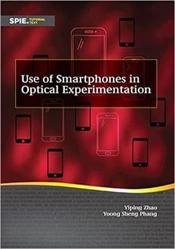Use of Smartphones in Optical Experimentation
- Добавил: literator
- Дата: 11-03-2023, 14:46
- Комментариев: 0
 Название: Use of Smartphones in Optical Experimentation
Название: Use of Smartphones in Optical ExperimentationАвтор: Yiping Zhao, Yoong Sheng Phang
Издательство: SPIE Press
Год: 2023
Страниц: 182
Язык: английский
Формат: pdf (true)
Размер: 39.6 MB
Use of Smartphones in Optical Experimentation shows how smartphone-based optical labs can be designed and realized. The book presents demonstrations of fundamental geometric and physical optical principles, including the law of reflection, the law of refraction, image formation equations, dispersion, Beer’s law, polarization, Fresnel’s equations, optical rotation, diffraction, interference, and blackbody radiation. Many practical applications―how to design a monochromator and a spectrometer, use the Gaussian beam of a laser, measure the colors of LED lights, and estimate the temperature of an incandescent lamp or the Sun―are also included. The experimental designs provided in this book represent only a hint of the power of leveraging the technological capability of smartphones and other low-cost materials to create a physics lab.
The most important smartphone component for the experimental applications in this book is its camera. The smartphone camera usually consists of two parts: the optical sensor array and the adaptive optical system. The standard optical sensor used in smartphones is an active-pixel sensor called the complementary metal oxide semiconductor (CMOS). A CMOS sensor array is a silicon-based integrated circuit consisting of a two-dimensional (2D) grid of light-sensitive elements called photosites. Each CMOS photosite contains a photodiode, a capacitor, and up to four transistors. The photodiode is the primary light-sensing component in the imaging system and is based on a reverse-biased p–n junction for capturing photogenerated electrons. To use the CMOS sensor in a smartphone camera to perform optical experiments, it is important to understand the following parameters: the resolution, the spectral response of the sensor, the SNR, and the linearity.
In this book, the smartphone camera is central to the experiments as a detector in several different contexts. To apply the smartphone camera to scientific experiments, there are several fundamental assumptions:
1. The sensor’s response to light intensity is linear: either the RGB values or the grayscale value is proportional to the light intensity provided that the photosite is not saturated.
2. All of the photosites in the sensor array are identical.
3. The spectral response of the sensors in the visible wavelength range is flat.
4. There is no image distortion.
5. The adaptive optical system can be treated as a single converging lens that can form a real image on the sensor array. The autofocus feature of the camera can adjust the effective focal length of the optical system so that the effective image distance of the camera is fixed; i.e., the distance between the sensor array surface and the effective lens is a constant for any image taken.
6. A scaling factor can be defined to convert the pixel length in a smartphone image to a real length.
The following precautions should also be taken during the experiments:
1. Avoid using the camera’s “auto” photography feature because it may automatically change the exposure time during consecutive image acquisition.
2. Avoid using flash photography during image acquisition.
3. Avoid high intensity of light flux because it will saturate the photosite(s).
4. Avoid using images that are very small (i.e., only a few pixels in size) for length calibration, wavelength calibration, or image identification.
5. Maintain a consistent smartphone orientation when taking images. In most smartphones, images taken with a vertically oriented smartphone will have different pixel dimensions than images taken with a horizontally oriented smartphone.
6. If a multi-camera system is used, select the standard wide-angle camera for experimentation.
This book can be used as a guide for undergraduate students and instructors for a hands-on experience with optics, especially for an online optical lab; elementary and high school science teachers to develop smartphone-based labs for classroom demonstrations; and anyone who wants to explore fundamental STEM concepts by designing and performing experiments anywhere.
Скачать Use of Smartphones in Optical Experimentation
[related-news] [/related-news]
Внимание
Уважаемый посетитель, Вы зашли на сайт как незарегистрированный пользователь.
Мы рекомендуем Вам зарегистрироваться либо войти на сайт под своим именем.
Уважаемый посетитель, Вы зашли на сайт как незарегистрированный пользователь.
Мы рекомендуем Вам зарегистрироваться либо войти на сайт под своим именем.
